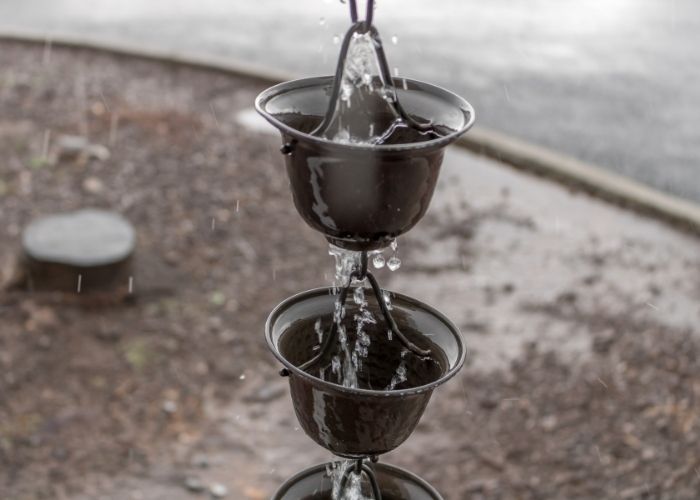Last Updated on January 14, 2022 by Fabiola L.
Rain is a precious source of water that can be harvested and used to grow plants. We have created the perfect guide on how to make self-watering rain gutter grow system plans.
This type of grow method is a clever way to conserve water, energy, and time. Nowadays, water is a valuable resource that is actually running out. Many aquifer sources are drying up while other freshwater bodies are becoming too polluted for use.
We need to take action in our daily lives to preserve water as much as possible. This method also makes use of old gutters that would normally enter our landfills.
As you may know, our landfills are rapidly filling up, and we have less space to put our waste. So anything we can do to avoid adding waste to this problem is a good thing.
This is why having self-watering rain gutter grow system plans is very useful. Read on to learn everything you need to know to build one at your home!
Setting Up A Gutter Gardening System
The rain gutter system is essentially using the concepts of hydroponics. Hydroponics is when you do not use soil or grow medium for the plants to sit in. Instead, the roots grow directly into the water.
Plant nutrients are put into the water to be absorbed. This can be done using a chemical, store-bought fertilizer, or homemade natural ones.
As you may have guessed, rain gutters are a crucial part of this design. Basically, the gutter acts as the water reservoir for your system.
Rain gutters were created to hold and move water. This is what makes it a perfect tool to re-use for a hydroponics project.
As you may know, gutters do not have a flat bottom. So you need something to support the gutters.
Typically people build a frame for their system out of wood. You need to build a structure that holds the gutters and the pots at the same time. A gutter is pretty thin so you can set it between the planks of wood that are holding the pots.
If you are doing it 100% hydroponically, you only need something to support the plants to float upright into the water. When the plants fall into the water, they will die.
You can fit a hose directly into the gutters, and this will spread water to all your plants. It is much easier than hand watering each plant individually.
Self Watering Gutter Garden
If you do not want to do this hydroponically, you can use soi in a pot lifted above the gutters. In this case, you must use the technology of a wicking system.
In order to do this, wicking material is placed at the bottom of your pots. This wicking material can be something like coconut fiber or burlap sacks. It drops from the bottom of your pot into the rain gutter water reservoir.
This method is very special because it is self-watering. The wicking material moves water from the gutters into the soil.
Plants only absorb the amount of water that they need. They will never take in more than they can handle. Once the soil gets saturated, the wicking stops.
People who do this rarely have to worry about watering their plants. The main thing you have to do is to keep an eye on your water reservoirs and fill up more water when it gets low.
Benefits Of Rain Gutter Grow System
Of course, with any plant operation, you will always need to do basic maintenance and observation. You will never be able to completely leave your garden alone unless you don’t care about its success. But, cutting out the watering is a huge task.
Often when we hand water or use a sprinkler, we are spraying all of the plants rather than directly to the roots. Using self-watering rain gutter grow system plans, you can avoid this problem altogether.
Also, since the plants only take in as much water as they need, you will never overwater. This means you save more water. Many people pay for their water, so using less water in your garden will save you money.
Secondly, in this system, you do not need to weed as much compared to a regular garden. Weeding is one of the biggest tasks for a gardener. So eliminating this task will save you a lot of time to work on other projects.
Negatives Of Self-watering Rain Gutter Grow System Plans
The only negative is that it takes some time to set up. You have to locate all your materials and make sure you create the perfect self-watering rain gutter grow system plans.
These plans will make sure you build everything accurately, so it lines up. Some people who do not have gutters use PVC piping. In this case, you have to drill holes and make sure the bottom of your pots are directly lined up.
If anything is not measured correctly, you will have to start again.
As with any garden, there will be animals that want to munch on your produce. If you leave this type of garden unattended, the same thing will happen.
You can build a small fence around your system to prevent unwanted visitors from entering.
Even though it takes a bit of work to set up, it is worth it in the end. This design ensures your plants are getting enough water without the owner needing to do much.
Water is super important for plants to grow. Over and under-watering are both serious issues that often kill your plants. With this design, you rarely will have this problem,
Follow our self-water rain gutter grow system plans to set one up in your home now! Feel free to comment and ask questions below. We are always happy to help more people set up sustainable aquaponics systems.
Read more about How To Make A Homemade Dutch Bucket Recirculating Drip System?

Candace is an aquaponics expert with over 5 years of experience in the field. She has a degree in environmental science from the University of California, Berkeley and a degree in aquaponics from the University of Florida. She is passionate about sustainable agriculture and has a deep knowledge of aquaculture and hydroponics. She has worked on numerous projects and has been involved in the development of aquaponic systems and fish farms. She also has experience in designing and constructing aquaponic systems. With her expertise, Candace is able to advise clients on the most effective and efficient way to construct and manage their aquaponic system. She is an active member of the aquaponic community, often speaking at conferences and seminars. Candace is dedicated to helping others understand the importance of aquaponics, and she is a strong advocate for sustainable food production.

